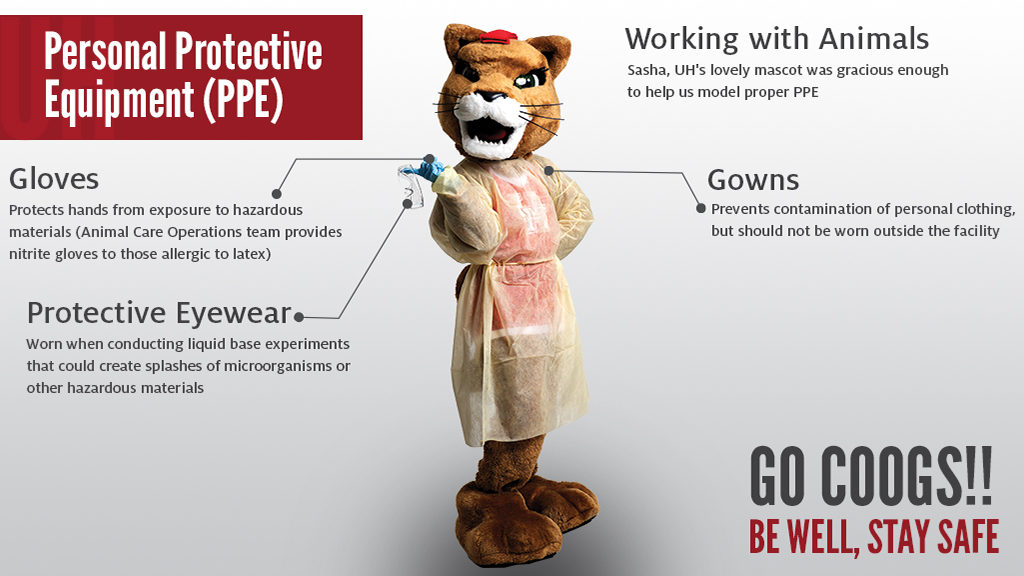Fashion does exist in a science lab. Although the attire may not be the latest trendy jacket or shoes, all the cool science kids wear PPE (personal protective equipment) while making discoveries and solving the world’s biggest mysteries.
Furthermore, consistently wearing PPE is extremely important and a critical part of the scientific process. “Appropriate personal protective equipment must be used to reduce exposure to infectious agents and contaminated equipment,” said Angelina Williams, clinical veterinarian with the University of Houston Animal Care Operations team.
“PPE also serves as a vital function of UH’s Occupational Health Program.”
Fending Off Our Furry Friends
PPE is used in many types of safety labs. For the purpose of this story, we’ll focus on PPE for an animal research facility. Whether someone is working with chemicals or a furry friend, safety precautions are still present and enforced. When dealing with animals, PPE protects researchers in various ways.
PPE Protects Personnel from…
- Laboratory Animal Allergies (LAA) – Dander from animals such as rodents and primates
- Infectious zoonotic disease – Rabies, Herpes B, Tuberculosis, Hepatitis Q
- Physical hazards – Bites, scratches, kicks, hearing loss from animal vocalization
Shasta and Sasha Weigh In
So what’s standard PPE in an animal research facility? I called on our Animal Care Operations prednisone online team and our very own UH mascot, Sasha, for help. In the image above, you will see Sasha model for us as we learn about the different types of protective equipment. PPE consists of:
Gowns – Prevents contamination of personal clothing, but should NOT be worn outside the facility
Gloves – Protects hands from exposure to hazardous materials (Our Animal Care Operations team provides nitrite gloves to those allergic to latex)
Protective Eyewear – Worn when conducting liquid based experiments that could create splashes of microorganism or other hazardous materials
There Are Levels to This..
The PPE listed above are the minimal requirements of protection when working with animals. I delved a bit deeper into PPE standards when things get extra hairy. According to the Centers for Disease Control and Prevention and the National Institutes of Health, there are four levels of biosafety and PPE requirements change depending upon the safety level.
BSL-1 (Minimal potential hazard) – PPE requirement: Protective gown, eyewear and gloves
BSL-2 (Moderate potential hazard) – PPE requirement: Protective gown, eye and face protection, gloves and eye, face and respiratory protection (Should be used in rooms containing infected animals)
BSL-3 (May cause serious or potentially lethal disease) – PPE requirement: Protective laboratory clothing with a solid front, eye and face protection, gloves and eye, face, respiratory protection
BSL-4 (High individual risk transmitted infections and/or life-threatening disease) – PPE requirement: Positive pressure suit. When this level occurs, trained responders are typically involved.
Working with animals to make scientific discoveries is rewarding and quite interesting. Moreover, like I’ve preached many times throughout the Big Bang series, safety is top priority. Not only is PPE important to the safety of researchers, but we also want to maintain the health and safety of our animal friends.
Well, that’s it for this edition of the Big Bang. Until next time…Be well and stay safe.



